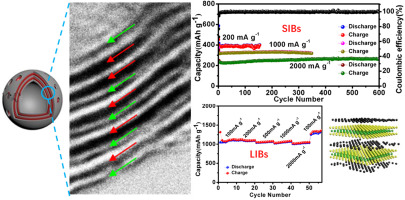Nano Energy ( IF 16.8 ) Pub Date : 2018-06-30 , DOI: 10.1016/j.nanoen.2018.06.084 Laiying Jing , Gang Lian , Feier Niu , Jian Yang , Qilong Wang , Deliang Cui , Ching-Ping Wong , Xizheng Liu

|
Despite high theoretical specific capacity and uniform interlayer channel for accommodation of ions, poor cycling stability and rate capacity have been identified as critical roadblocks to further development of MoS2-based lithium ion batteries (LIBs) or sodium ion batteries (SIBs). In this study, few-atomic-layered MoS2 hollow nanospheres with expanded interlayer spacing, due to alternate intercalation of N-doped monolayer carbon (m-C) between the adjacent MoS2 monolayers, have been designed and synthesized via an annealing-followed soft-template approach. As an anode of SIBs, the ultrathin-layered m-C/MoS2 superstructures electrode can deliver a reversible discharge capacity of 401 mA h g−1 at 200 mA g−1 after 150 cycles. It can maintain 262 mA h g−1 at 2000 mA g−1 after 600 cycles with a capacity retention of 105% in comparison with that of the 2nd cycle. For LIBs, the hollow nanospheres can also deliver a reversible discharge capacity of 1025 mA h g−1 at 1000 mA g−1 after 80 cycles. The excellent electrochemical performance can be attributed to the synergy effect of expanded interlayer spacing (improving ion diffusion mobility), ultrathin feature (shortening ion diffusion paths) and alternate intercalation of monolayer carbon (improving the electrical conductivity and maintaining the structural integrity), which ensures new opportunities for designing advanced two-dimensional hosts for energy storage devices.
中文翻译:

由碳和MoS 2单层交替插层构成的少量原子层空心纳米球,用于钠和锂的存储
尽管具有较高的理论比容量和均匀的层间通道来容纳离子,但不良的循环稳定性和倍率容量已被认为是进一步开发基于MoS 2的锂离子电池(LIB)或钠离子电池(SIB)的关键障碍。在这项研究中,由于退火相邻的MoS 2单层之间交替掺杂N掺杂的单层碳(mC),设计并合成了少数具有原子间距的MoS 2空心纳米球,层间间距扩大了。模板方法。作为SIB的阳极,超薄mC / MoS 2超薄结构超级电极在200 mA g时可提供401 mA h g -1的可逆放电容量150个循环后为-1。600次循环后,在2000 mA g -1下可以保持262 mA h g -1,与第二次循环相比,其容量保留率为105%。对于LIB,中空纳米球还可以在80个循环后在1000 mA g -1下提供1025 mA h g -1的可逆放电容量。优异的电化学性能可归因于扩大的层间间距(提高离子扩散迁移率),超薄特征(缩短离子扩散路径)和交替插入单层碳(提高电导率并保持结构完整性)的协同效应。为储能设备设计高级二维主机的新机会。










































 京公网安备 11010802027423号
京公网安备 11010802027423号